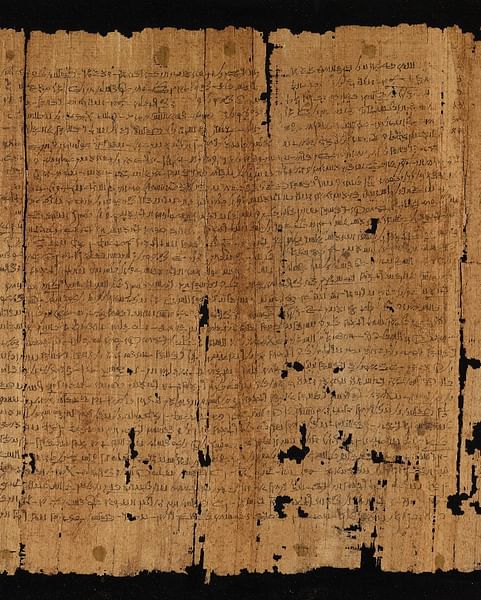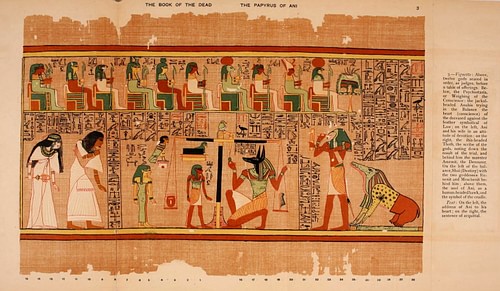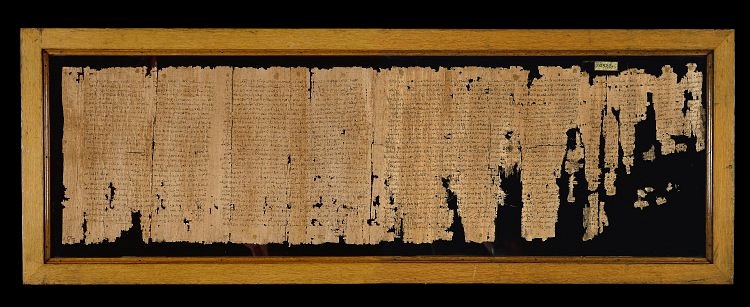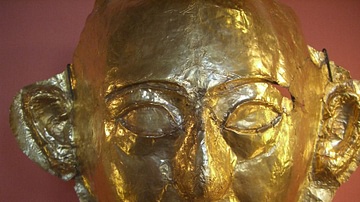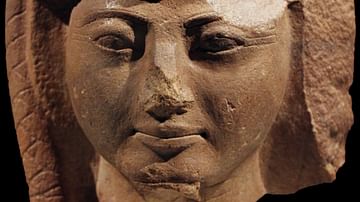Setna II (also Setna Khaemaus and Si-Osire) is a work of ancient Egyptian literature from Roman Egypt (30 BCE - 646 CE) written in demotic script. It is part of a cycle of stories known as the Tales of Prince Setna featuring a character based on Khaemweset (c. 1281- c. 1225 BCE), the fourth son of Ramesses II (1279-1213 BCE).
Khaemweset is known as the 'First Egyptologist' for his devotion to recording and preserving the monuments and temples of Egypt's past during the era known as the New Kingdom (c. 1570-1069 BCE). Setna II is thematically linked to the earlier story, Setna I, from the Ptolemaic Period (323-30 BCE) which cleverly uses Khaemweset's habit of entering old tombs as a plot device. This story draws on Khaemweset's reputation as a wise man.
Khaemweset was legendary by the time of the Roman Period as a sage and magician who was able to understand ancient writings and work powerful spells. In Setna II, however, he takes a secondary role to his son, Si-Osire, who is an even greater magician than he is. Si-Osire is a wholly fictional character, not based on anyone in Khaemweset's life, who epitomizes the powerful magician in Egyptian literature. He matures mentally and physically at a rapid rate, has access to the afterlife which he is able to visit at will, can understand the most difficult texts, and can even read books without opening them. His great abilities are explained toward the end of the story in the climactic scene.
The beginning of Setna II is missing but has been reconstructed from contextual clues in the extant manuscript (Papyrus No. 604 of the British Museum). The story is usually translated as divided into four chapters: Setna Khaemaus and Si-Osire; The Nubian Sorcerer; The Contents of the Document; Si-Osire Reveals Himself. The following is a detailed summary of the story.
Setna Khaemaus and Si-Osire
The story begins with Setna's wife, Mehusekhe, praying for divine assistance in getting pregnant and, in a dream, receiving assurance. She becomes pregnant shortly afterwards, and Setna then has a dream in which the god tells him, "The boy that shall be born shall be named Si-Osire. Many are the wonders that he shall do in Egypt" (Lichtheim, 138). When the child is born, he is given the name the gods spoke and the parents are overjoyed in having a special son whom the gods have singled out for greatness.
Si-Osire matures quickly and soon shows himself wiser than his teachers at school. His abilities in understanding texts as well as interpreting the world around him attract a great deal of attention and Setna is quite proud and wants to honor him at a banquet for his father the pharaoh.
As they are preparing for the banquet, Setna looks out his window and sees two funeral processions passing by on their way to the necropolis. The first is for a wealthy man, and there are many mourners following the coffin, loud lamentations, and all the honors one could hope for. The second is not even a procession but only a poor dead man wrapped in a mat with no ceremony and none to mourn him. Setna, watching from his window, reflects, "how much happier is the rich man who is honored with the sound of wailing than the poor man who is carried to the cemetery" (Lichtheim, 139).
This seems to be a simple observation of fact to him, but his son answers, saying "May it go with you in the netherworld as it will go with this poor man in the netherworld! May it not go with you as it will go with this rich man in the netherworld!" (Lichtheim, 139).
Setna's feelings are hurt and he demands to know how his son could speak to him this way. Si-Osire simply replies that, if his father wishes, he can show him the ultimate fate of both men. He takes his father's hand and leads him to the western desert and down into the underworld. There they see people who had no luck in life, and blamed others instead of themselves, trying to plait ropes together, but before they can finish, donkeys chew through their work. Their efforts are as futile in the afterlife as they were on earth because they accepted no personal responsibility. There are others they pass who reach for food and water above them, but before they can get to these, trenches are dug at their feet and they slip and slide and cannot reach their goal. These people, Si-Osire explains, are those who were grasping in life, never content, and remain the same in death.
They pass by a man in obvious torment, crying loudly, crushed in the pivot of a door and then, as they reach the chamber of judgment, they see a rich man dressed in fine garments standing near Osiris. Si-Osire tells Setna that this richly rewarded soul, who is obviously justified by the gods, is the poor man whose funeral they saw earlier. The tormented man in the door's pivot is the rich man who engaged in many misdeeds on earth and now must pay for them in the afterlife. Si-Osire explains: "He who is beneficent on earth, to him one is beneficent in the netherworld. And he who is evil, to him one is evil. It is so decreed and will remain so forever" (Lichtheim, 141). He takes his father's hand and leads him out of the underworld.
Setna is amazed at all he has seen and wants to tell everyone about it but understands he cannot. He will have to content himself with being proud of his son who has such amazing power and wisdom without bragging about him to others. As it turns out, though, he has nothing to worry about on this score because, before the age of 12, Si-Osire has distinguished himself as the wisest sage in the land and the most powerful magician.
The Nubian Sorcerer
Years later, once Si-Osire is fully mature, a Nubian sorcerer appears at court with a challenge. He has a scroll strapped to his body and asks if any are wise and powerful enough to read it without breaking its seal or opening it; if no one at court can accomplish this deed then he will return to his country and tell everyone there of the shame of Egyptian sages. Pharaoh calls instantly for Setna and asks his advice, but Setna has no idea how one can read a scroll without breaking the seal and opening it. He asks for ten days in which to solve the problem and is granted the time, but it does not matter; he cannot understand how to answer the challenge and becomes increasingly depressed.
His wife Mehusekhe tries to console him and get him to talk about his problems, but he tells her she cannot help. Si-Osire then comes to his father and also tries, but Setna tells him there is nothing he can do. Si-Osire refuses to leave, however, until his father explains the problem. When Setna tells him about the Nubian sorcerer's challenge, Si-Osire begins to laugh. This upsets Setna who asks what he is laughing about, and his son tells him that it is silly to be so concerned about such a small matter; he can read the scroll without breaking the seal or opening it.
Since Setna does not believe this is possible, he asks for proof. Si-Osire tells him to go to the ground floor of the house to his library, while Si-Osire will remain upstairs in his father's room. Setna is to take books, one by one, out of his library's chest and hold them up, and Si-Osire, without seeing what they are or being anywhere near the room, will call down to him what they are and what is in them. Setna does as his son requests and Si-Osire passes the test. Setna quickly runs to pharaoh and tells him the problem is solved. They hold a banquet in honor of Si-Osire and set a time for the next day for Setna's son to meet the challenge of the Nubian sorcerer.
The Contents of the Document
The next day the Nubian sorcerer is called to the court and stands beside Si-Osire in front of the pharaoh. Si-Osire then relates what is written in the scroll:
Many years in the past, in a prosperous time for Egypt under a good king, the Nubians were jealous of the country's fortunes and three Nubian sages were discussing what they would do to the pharaoh and Egypt if they were given leave and need not fear the wrath of the gods. The king of the Nubians is resting nearby and hears them as they speak. The first claims that, if he were given leave, he would plunge Egypt into darkness for three days and three nights. The second says he would have the pharaoh kidnapped by spirits, brought to Nubia, given 500 blows in public, and returned to his palace within six hours. The third says he would cause Egypt to become barren for three years. All three agree, though, that they cannot do this without the consent of the king who has the approval of the gods.
The king instantly has them brought to him, questions them on their plans, and tells the second one - named Horus-son-of-the-Nubian woman - to proceed. The sage makes a litter and four litter-bearers of wax, performs a magic spell to bring them to life, and sends them to Egypt to kidnap the pharaoh. They do as they are told and return with the pharaoh who is beaten with 500 blows and then returned to his palace within six hours of the night.
Si-Osire pauses here to challenge the Nubian sorcerer to confirm what he has said: "May the wrath of Amun, your god, smite you! These words that I have spoken, are they not the ones that are written in the document that is in your hand?" Said the chieftain of Nubia: "Go on reading. All the words that you have spoken are true" (Lichtheim,145).
Si-Osire continues with the story as the pharaoh, waking up the next morning bruised, calls his councilors to ask how long he has been away and what has happened since he was gone. The councilors worry he may be sick or mad and tell him it is morning after the previous night and he has gone nowhere. He shows them his bruises and tells them what he experienced and they are amazed. He begs them to find someone who can protect him because he cannot endure another beating.
A great sage named Horus-son-of Paneshe volunteers his services. He promises the pharaoh protection and revenge and goes to meditate in the temple and then sleep. In a dream, the god Thoth tells him where to find a magic book, written in Thoth's own hand, which will work wonders and save Egypt. Horus-son-of-Paneshe wakes, finds the book, and sets up magical protection around the pharaoh. That night, when the Nubian spirits come again, they cannot reach the king and return to their country.
Horus-son-of-Paneshe then creates his own wax litter and litter-bearers and sends them to Nubia. They kidnap the Nubian king, bring him to Egypt where he is beaten with 500 blows and is returned to his palace within six hours of the night. After relating this, Si-Osire again pauses to demand that the Nubian confirm the truth of the narrative he has spoken, and the sorcerer says that it is so.
Si-Osire then relates the last part of the scroll beginning with the Nubian king summoning Horus-son-of-the-Nubian-woman and berating him for his failure. Not only can they no longer attack the pharaoh but now he, the Nubian king, has been taken to Egypt and beaten in public with 500 blows. He warns the sage that he had better do something about the situation.
Horus-son-of-the-Nubian-woman goes to consult with his mother, also a powerful magician, and she warns him not to go to Egypt because the Egyptian sage's power will be stronger there. He tells her there is nothing else he can do, and she instructs him to set up magical signs so that, should he get into trouble, she can hurry there to help him. The sage agrees and sets off for Egypt.
He arrives at the court of the pharaoh and challenges the unknown magician who has been thwarting his spells to appear and face him. Horus-son-of-Paneshe appears, and the two find out they knew each other when younger. Horus-son-of-Paneshe once rescued the Nubian from death and Horus-son-of-the-Nubian-woman had taught the Egyptian the language of wolves. Their former friendship is forgotten, however, and they begin their duel.
Horus-son-of-the-Nubian-woman creates an enormous fire in the court which begins to rage; Horus-son-of-Paneshe summons clouds which pour rain down and extinguish the flames. Horus-son-of-the-Nubian-woman then calls up a great vault of stone which surrounds the pharaoh and the nobles and encloses them; Horus-son-of-Paneshe creates a sky-boat which lifts the vault into the air and carries it away to a lake. The Nubian sage then realizes he cannot beat the Egyptian and makes himself invisible in order to escape. Horus-son-of-Paneshe breaks the spell and reveals him. Horus-son-of-the-Nubian-woman has turned himself into a gander to slip away but is caught by a fowler to stands over him with a knife.
At this moment, the mother of the Nubian sage appears in the form of a wild goose flying down to save her son. Horus-son-of-Paneshe recognizes her true form, casts a spell, and she falls to the ground where another fowler places a knife against her throat. She quickly changes back into the form of a woman and begs for her life and that of her son. She promises that, if the Egyptian sage will only allow them to depart, they will never return to Egypt again. Horus-son-of-Paneshe agrees to this but makes the Nubian sage swear an oath that he will not set foot in Egypt for 1,500 years; the Nubian swears and he and his mother are given a sky-boat by Horus-son-of-Paneshe which takes them back to Nubia.
Si-Osire Reveals Himself
When Si-Osire finishes speaking, everyone in the court is silent and the Nubian sorcerer stands with his head bowed in defeat. Si-Osire then tells the assembly that this man is, in fact, Horus-son-of-the-Nubian-woman from the story who has returned after 1,500 years to destroy Egypt. He then tells them that he, Si-Osire, is the reincarnation of Horus-son-of-Paneshe whom the gods allowed to return to earth for just this purpose. He says the order was given by Osiris himself, who sees all things, that he should rise up from the underworld on wings and find himself born again on earth to defeat the sorcery of the king's enemy.
Si-Osire then turns on the Nubian sorcerer, casts a spell, and encircles him in flames which consume him. As the sorcerer is destroyed, Si-Osire vanishes also; the fire goes out and the court is as it was before. Setna cries for his son while the others stand around in amazement. Pharaoh rises from his throne to console Setna, telling him that his son saved Egypt and will never be forgotten. The story ends as Mehusekhe again prays for a child and lays down with Setna. The couple has another son whom they love, but Setna never forgets Si-Osire and continues to honor him with food and drink offerings for the rest of his life.
Commentary
Setna II draws on an ancient tradition of Near East literature in which two powerful magicians face off against each other in a battle for supremacy. This theme is dealt with in a number of different ways in Mesopotamian literature but, most famously, in the Sumerian cycle known as The Matter of Arata. In the story Enmerkar and Ensuhgirana, the sorcerers Urgirinuna of Hamazi and the Wise Woman of Eresh, Sagburu, fight a duel in which Sagburu's magic is superior, and after defeating Urgirinuna, she hurls him into the Euphrates. These tales, whatever form they took, were quite popular in that they touched upon a central Mesopotamian value: order triumphing over chaos.
This same concept was important in ancient Egyptian culture as it was believed that the gods had created the ordered world of duality and individuality from the primordial oneness of chaos through the power of magic. The god of magic, Heka, was thought to have been present at the act of creation, and it was his power which sustained ma'at, divine harmony and balance, which allowed the universe to function properly.
Magic was integral to the ancient Egyptian understanding of the world and was a vital component in medical practice, exorcism, mortuary rituals, protective charms, tattoos, and many other aspects of daily life. The motif of two magical antagonists dueling each other, then, would have been familiar to an audience used to physician-magicians and priest-magicians using their skills to heal and maintain order.
Setna II pits the champion of order and honor against the force of chaos and duplicity. In the story, Egypt has done nothing to offend the Nubian king or Horus-son-of-the-Nubian-woman, but they decide to strike against Egypt through magic only because they are jealous of their neighbor's success and prosperity. In addition to entertaining an audience, the tale would have emphasized national pride, vilified non-Egyptians, and reminded people of the dangers of coveting others' success.
While the sages' battle draws on ancient Sumerian motifs, the earlier section in which Setna and Si-Osire visit the underworld makes use of Greek mythology. The souls they pass in the afterlife are tormented with the kinds of punishments one finds in the Greek tales of the Daughters of Danaus, Sisyphus, and Tantalus, in which one's deeds on earth are mirrored by one's punishment in the next life. As Setna II was influenced by earlier works, so would it influence later ones. Lichtheim, citing the work of Gressmann, points out that the story of the wealthy man and the poor man in Setna II has been identified as the source for the tale of the rich man and Lazarus in the biblical Book of Luke 16:19-31.
The story is richly textured on many levels, but among the most interesting aspects is its reliance on the concept of the Transmigration of Souls, better known as reincarnation. Throughout Egypt's history, the afterlife was seen as a continuation of one's earthly journey which, hopefully, led one to paradise in the Field of Reeds. A belief in reincarnation, however, ran concurrently with this vision and was more - or less - popular in differing eras. In Setna II, this belief is used effectively in making Si-Osire a reincarnated sage sent back to earth by the gods specifically for one single moment in time. This would have assured an audience that the gods were aware of unseen dangers, were able to take measures against them, and had Egypt's safety and prosperity always in hand.
